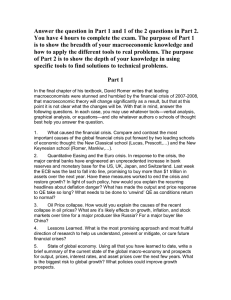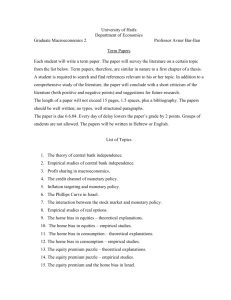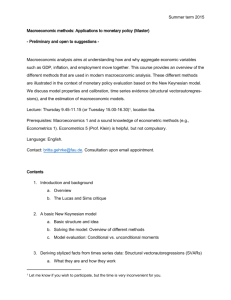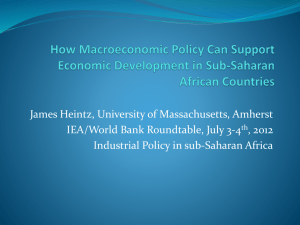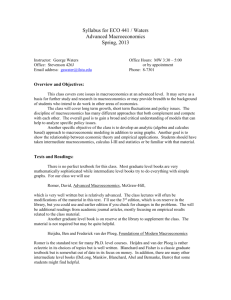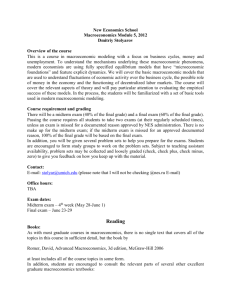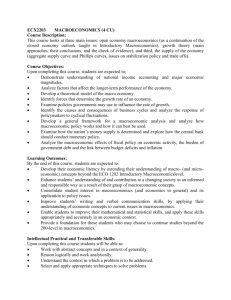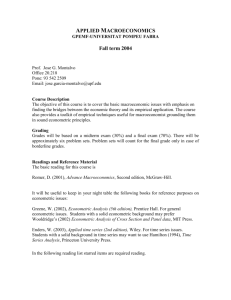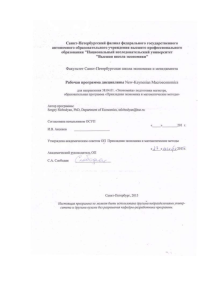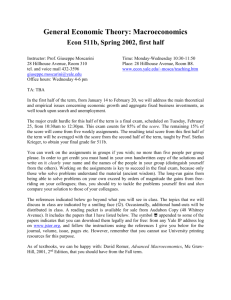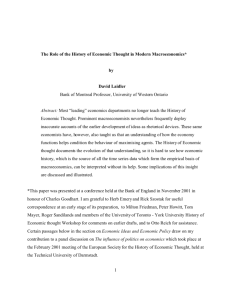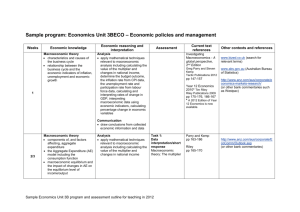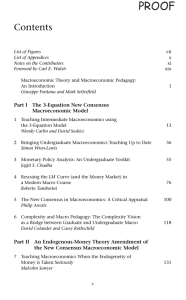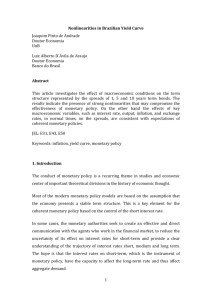Syllabus - College of Business Administration
advertisement
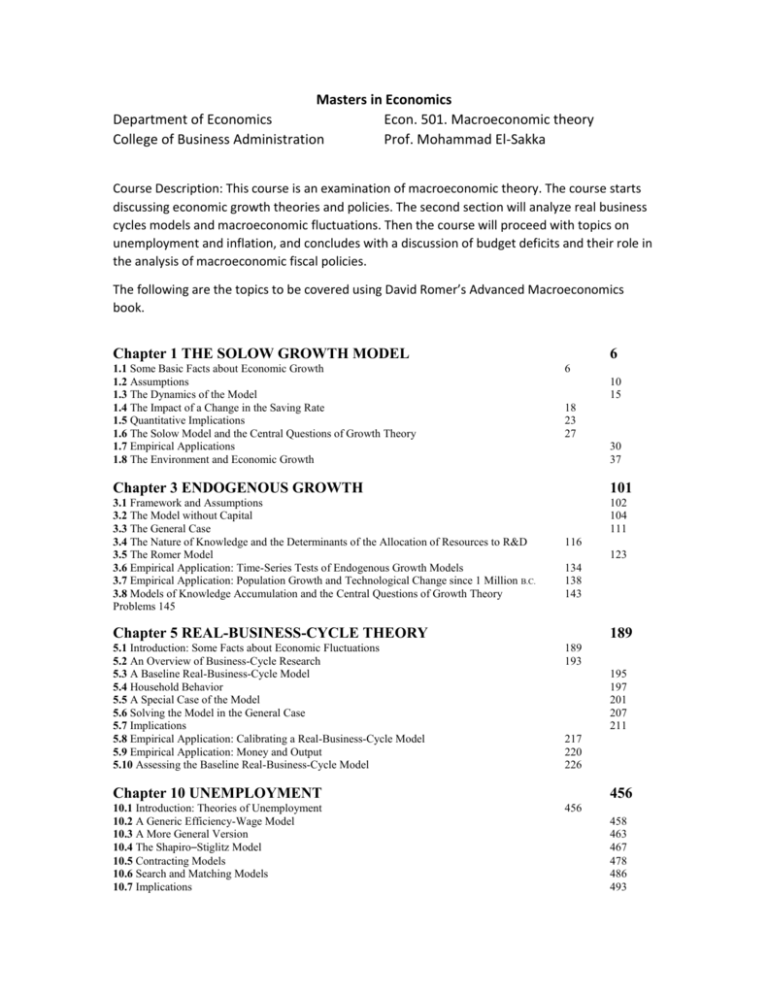
Masters in Economics Department of Economics Econ. 501. Macroeconomic theory College of Business Administration Prof. Mohammad El-Sakka Course Description: This course is an examination of macroeconomic theory. The course starts discussing economic growth theories and policies. The second section will analyze real business cycles models and macroeconomic fluctuations. Then the course will proceed with topics on unemployment and inflation, and concludes with a discussion of budget deficits and their role in the analysis of macroeconomic fiscal policies. The following are the topics to be covered using David Romer’s Advanced Macroeconomics book. Chapter 1 THE SOLOW GROWTH MODEL 1.1 Some Basic Facts about Economic Growth 1.2 Assumptions 1.3 The Dynamics of the Model 1.4 The Impact of a Change in the Saving Rate 1.5 Quantitative Implications 1.6 The Solow Model and the Central Questions of Growth Theory 1.7 Empirical Applications 1.8 The Environment and Economic Growth 6 6 10 15 18 23 27 30 37 Chapter 3 ENDOGENOUS GROWTH 101 3.1 Framework and Assumptions 3.2 The Model without Capital 3.3 The General Case 3.4 The Nature of Knowledge and the Determinants of the Allocation of Resources to R&D 3.5 The Romer Model 3.6 Empirical Application: Time-Series Tests of Endogenous Growth Models 3.7 Empirical Application: Population Growth and Technological Change since 1 Million B.C. 3.8 Models of Knowledge Accumulation and the Central Questions of Growth Theory Problems 145 102 104 111 116 123 134 138 143 Chapter 5 REAL-BUSINESS-CYCLE THEORY 5.1 Introduction: Some Facts about Economic Fluctuations 5.2 An Overview of Business-Cycle Research 5.3 A Baseline Real-Business-Cycle Model 5.4 Household Behavior 5.5 A Special Case of the Model 5.6 Solving the Model in the General Case 5.7 Implications 5.8 Empirical Application: Calibrating a Real-Business-Cycle Model 5.9 Empirical Application: Money and Output 5.10 Assessing the Baseline Real-Business-Cycle Model 189 189 193 195 197 201 207 211 217 220 226 Chapter 10 UNEMPLOYMENT 10.1 Introduction: Theories of Unemployment 10.2 A Generic Efficiency-Wage Model 10.3 A More General Version 10.4 The Shapiro–Stiglitz Model 10.5 Contracting Models 10.6 Search and Matching Models 10.7 Implications 456 456 458 463 467 478 486 493 10.8 Empirical Applications 498 Chapter 11 INFLATION AND MONETARY POLICY 11.1 Inflation, Money Growth, and Interest Rates 11.2 Monetary Policy and the Term Structure of Interest Rates 11.3 The Microeconomic Foundations of Stabilization Policy 11.4 Optimal Monetary Policy in a Simple Backward-Looking Model 11.5 Optimal Monetary Policy in a Simple Forward- Looking Model 11.6 Additional Issues in the Conduct of Monetary Policy 11.7 The Dynamic Inconsistency of Low-Inflation Monetary Policy 11.8 Empirical Applications 11.9 Seignorage and Inflation 513 514 518 523 531 537 542 554 562 567 Chapter 12 BUDGET DEFICITS AND FISCAL POLICY 12.1 The Government Budget Constraint 12.2 The Ricardian Equivalence Result 12.3 Ricardian Equivalence in Practice 12.4 Tax-Smoothing 12.5 Political-Economy Theories of Budget Deficits 12.6 Strategic Debt Accumulation 607 12.7 Delayed Stabilization 617 12.8 Empirical Application: Politics and Deficits in Industrialized Countries 623 12.9 The Costs of Deficits 628 12.10 A Model of Debt Crises 632 Problems 639 584 586 592 594 598 604 TEXT BOOKS Required: 1. Required Text: David Romer, Advanced Macroeconomics. 4th edition. New York, McGraw-Hill ISBN-13: 978-0073511375 2. Wendy Carlin and David Soskice (2005) Macroeconomics: Imperfections, Institutions and Policies " ISBN-13: 978-0-19-877622-2 3. Some selected readings and papers will be distributed during the class. Recommended Texts: Robert J. Barro and Xavier Sala-i- Martin, Economic Growth, MIT Press STUDENT EVALUATION SYSTEM Students are evaluated based on their level of achievement in the following: Exams There will be three in-class examinations including the final. These tests will be multiple choice, numerical, and essay questions. The tests and quizzes will carry a total of 100 points. The weights are follows. Mid term 1 20 points Presentations 20 points Participation 10 points Short papers 20 points Final 30 points Total 100 Plagiarism and cheating are strictly prohibited by university policies as well as academic ethics. Grading System Grade will be assigned based on the following scale: 73% < Mark < 77% 77% < Mark < 80% 80% < Mark < 83% 83% < Mark < 87% 87% < Mark < 90% 90% < Mark < 95% 95% < Mark < 100% C C+ BB B+ AA OFFICE HOURS There will be three weekly office hours a week took place in the teacher's office in the second floor in the faculty building. Students could also meet the instructor by making special appointment if the announced office hours are not suitable for him/her. Making phone calls with the teacher is strictly prohibited except in urgent circumstances. Absenteeism: Students are required to attend classes regularly. There are formal penalties for missing classes according to the University's rules. Tardiness: Student who arrives late will be first notified and prevented from attending the class if such conduct continues. Make up policy Students who miss an exam as a result of illness or other extenuating circumstances (verifiable documentation of the circumstances must be provided) may ask for make-up exam or may request to add it to the final exam grades. Note: Mobile phones must be kept silent during lectures.
